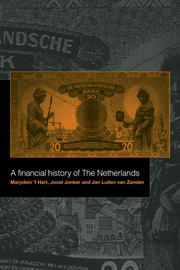Book contents
- Frontmatter
- Contents
- List of figures
- List of tables
- The Republic of the Seven United Provinces
- The Kingdom of the Netherlands
- 1 Introduction
- 2 The merits of a financial revolution: public finance, 1550–1700
- 3 Linking the fortunes: currency and banking, 1550–1800
- 4 From fragmentation to unification: public finance, 1700–1914
- 5 The alternative road to modernity: banking and currency, 1814–1914
- 6 Old rules, new conditions, 1914–1940
- 7 Towards a new maturity, 1940–1990
- 8 Conclusion
- Glossary
- Bibliography
- Index
5 - The alternative road to modernity: banking and currency, 1814–1914
Published online by Cambridge University Press: 03 February 2010
- Frontmatter
- Contents
- List of figures
- List of tables
- The Republic of the Seven United Provinces
- The Kingdom of the Netherlands
- 1 Introduction
- 2 The merits of a financial revolution: public finance, 1550–1700
- 3 Linking the fortunes: currency and banking, 1550–1800
- 4 From fragmentation to unification: public finance, 1700–1914
- 5 The alternative road to modernity: banking and currency, 1814–1914
- 6 Old rules, new conditions, 1914–1940
- 7 Towards a new maturity, 1940–1990
- 8 Conclusion
- Glossary
- Bibliography
- Index
Summary
Introduction
From about 1780, The Netherlands dropped back from a leading position in trade and banking to a rank more befitting its size, content to follow international developments rather than steering them. For long, this downgrading was hidden and softened by the riches accumulated during the Golden Age, which ensured Amsterdam a continuing position in international finance. The character and importance of that position changed irrevocably as well, however. In 1834 the government of the United States moved their European account from W. & J. Willink of Amsterdam to Rothschild in London (Chapman 1984, p. 21). From the end of the 1840s Hope & Co.'s unique hold over Russian government issues slipped (Platt 1984, pp. 70–2). Around 1850 several big German–Jewish bankers shut their Amsterdam branches, sealing the city's slide to second rank.
The adaptation to changed economic circumstances proved long and painful. Industrialisation and corporate joint-stock banking both came late in the nineteenth century, inspiring many observers to suggest a negative link between the two, blaming conservative bankers and wary investors for the prolonged economic decline. If that suggestion fails to stand up to scrutiny, it still leaves to be explained what actually happened in Dutch banking during the nineteenth century.
The themes dominating this period may be summed up as the evolution towards a national economy in tandem with a financial system centred on Amsterdam, and the slow emancipation of banking from trade and other activities. Only the convergence of these developments in the decade after 1860 created the opportunities for the first joint-stock banks. As an important proxy to the first two factors the currency vicissitudes will be treated first.
- Type
- Chapter
- Information
- A Financial History of the Netherlands , pp. 94 - 123Publisher: Cambridge University PressPrint publication year: 1997
- 14
- Cited by



